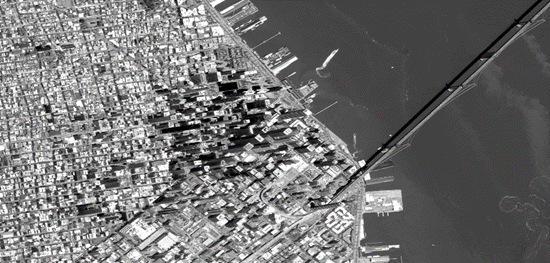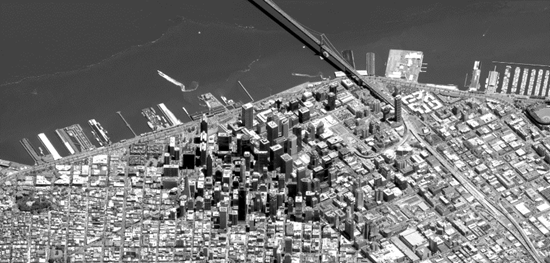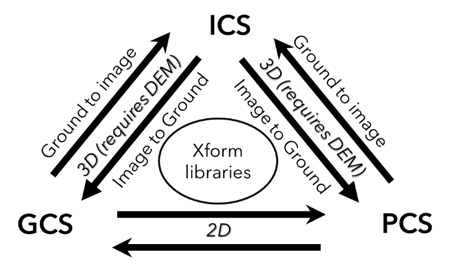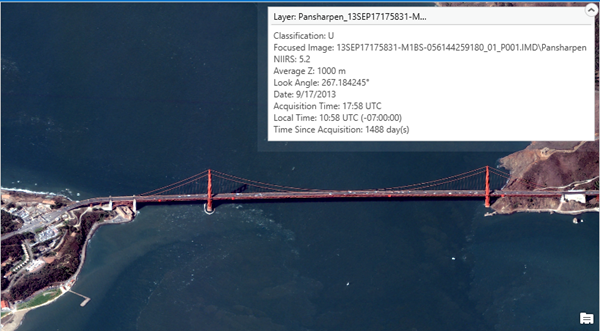Available with Image Analyst license.
When a sensor collects a picture and forms an image, it captures the scene in perspective geometry. As a result, the image has its own unique mapping of the 3D world into that specific 2D image. For remotely sensed images, this geometry is described in a sensor model that accompanies the image in the metadata. The perspective mode of the map view display provides the capability to display oblique imagery in an image coordinate system, called image space, rather than a map coordinate system to enable more intuitive image interpretation. It facilitates seamless transformation between an image coordinate system (ICS) and map coordinate system to display, interpret, collect, and edit GIS feature data on the perspective imagery.
Image space analysis capabilities
The following are reasons why utilizing an ICS in image space is particularly useful for the image analyst:
- Oblique and perspective imagery is displayed in its natural orientation and is conducive to intuitive image interpretation.
- The image is not resampled so it retains its original clarity and is distortion free.
- It provides a full coordinate transformation between image and ground. Thus, any geographic information you want to display in image space is transformed to ICS and accurately overlaid on the image and symbolized as it would be normally.
- Any other imagery brought into the image space display frame is also transformed to the focus image displayed in ICS.
- Features and objects can be located and accurately measured in image space with results given in the units of choice.
- Features can be created and edited in image space using standard creation and editing tools and saved in a geodatabase in the map coordinate system of choice.
Use imagery in perspective mode
Imagery is often collected at significant angles, referred to as oblique imagery. It is useful for ascertaining information about features such as building facades and other infrastructure that is not obtainable from vertical imagery. Satellite imagery is often collected at angles greater than 15 degrees off-nadir, as is aerial and drone imagery.
The most common type of analysis of oblique imagery is manual image interpretation. Human cognition is very effective in the visual interpretation of imagery. This includes not only the assessment of image content but also the meaning and relationships of this content, and recognizing spatial patterns, detecting change, and rate of change in monitoring applications. Oblique imagery is particularly useful for reconnaissance, surveillance, and situational awareness for a variety of applications such as emergency management and response.
Displaying any kind of imagery in a map-based coordinate system, called map space, is inherently distorted, stretched, and twisted to fit accurately to a 2D flat map. Imagery for mapping purposes is collected specifically for viewing in a map context. It is collected vertically so the amount of distortion is minimal, and orthorectification techniques correct imagery so it aligns more closely with the map. However, with oblique imagery, distortions can be severe, making it difficult to interpret the image. ArcGIS Image Analyst allows you to work with oblique imagery in its native geometry rather than in map space. Unprojected imagery viewed in the orientation in which it was collected is displayed in image space in the map view. Displaying imagery in image space enables you to work with the imagery in a more natural way and bring GIS and map data to the image.
When displaying imagery in map space, images are often displayed with North oriented up at the top of the display. Because oblique imagery is collected from a variety of different viewing angles, displaying oblique imagery in map space with North oriented up, causes buildings and other ground features to appear to lean at a variety of disorienting angles, making oblique imagery hard to interpret.
The following satellite image shows an oblique image displayed in traditional map space, with north up and the image orthorectified on the fly to be properly registered to the basemap. 
Note how the buildings in the image lean to the northeast, making image interpretation difficult.
The following satellite image shows the oblique image in image space, undistorted and rotated with buildings displayed vertically in a more natural orientation. 
The oblique image displayed in image space mode is inherently more intuitive for image interpretation.
You can work with any supported raster dataset having the basic required metadata. The required metadata includes sensor model (for example, Rational Polynomial Coefficient [RPC], frame camera model, and so on) files commonly associated with satellite imagery, or block-adjusted aerial imagery in a mosaic dataset. Imaging platform information at acquisition time such as x, y, z position, azimuth and elevation for satellite data, and exterior orientation for aerial imagery, along with pixel size are used to properly orient the imagery in ICS. From the Contents pane, turn on the focus for the image you want to work with, and it is displayed in perspective mode in the map view display based on the ICS.
Enable your imagery for analysis in perspective mode
Traditional map projection systems include geographic coordinate systems and projected coordinate systems. These 2D coordinate systems are reference systems used to represent the locations of imagery and geographic features within a common geographic framework. The basis for the image space is a third reference system called the image coordinate system (ICS).
Geographic coordinate systems (GCS) and projected coordinate systems (PCS) are 2D map transforms, while the ICS is a full 3D transform. It works for imagery, but it also works for all other data in the GIS. The image coordinate system seamlessly transforms imagery and GIS data in the column and row image space into map space in a bidirectional manner.

Heads-up display
When your image is displayed in perspective mode with buildings aligned vertically, important metadata about the image is displayed in a heads-up display window. This information consists of the file name as well as information that is most relevant to the interpretation of the image, including items such as image quality, obliquity angle, date of acquisition, time of acquisition, and computed fields such as the local time of acquisition and the lapse in time since the acquisition. The heads-up display is designed to minimize the need for you to go back to the ribbon to access information that normally is used when analyzing and exploiting an image. This enables you to view essential metadata for each oblique image you display, which is useful when working with several images such as a time series.

You can choose what type of metadata to include in your heads-up display window. The heads-up display window can also be minimized to maximize the image display area.
Collect features in image space
Oblique imagery is conducive to image interpretation, and features can be collected using the standard ArcGIS Pro feature creation and editing functionality. Features and objects are manually collected in the ICS and automatically transformed into your map projection system of choice. Additionally, existing GIS layers in your map projection can be properly overlaid on the image in ICS, updated, and saved. Use a DEM to position your image more accurately and to collect your feature data in 3D. Feature data is saved in a geodatabase or as a shapefile.
Summary
The range of capabilities available in image space display enable image analysts to effectively interpret and collect information from oblique imagery. The ICS facilitates bidirectional transformations between perspective mode image space and map space, which permits analysts to collect and analyze data in either mode. Standard image mensuration functionality, feature creation, and editing capabilities are supported in perspective mode, allowing you to work efficiently and effectively in operational environments.